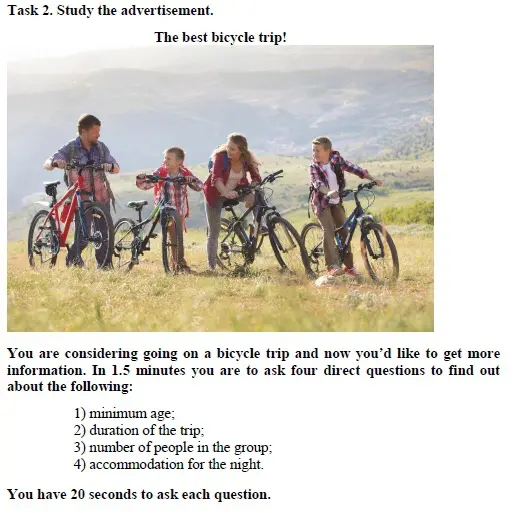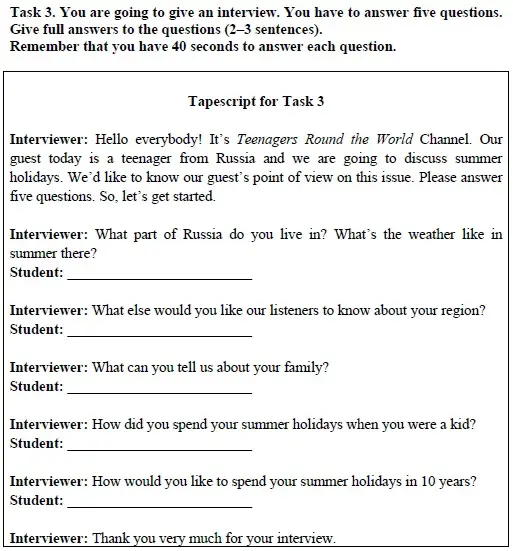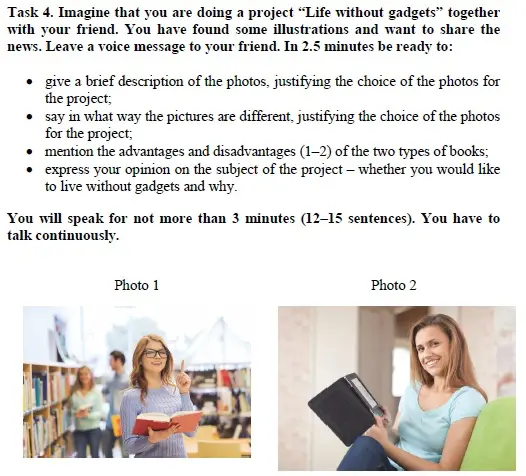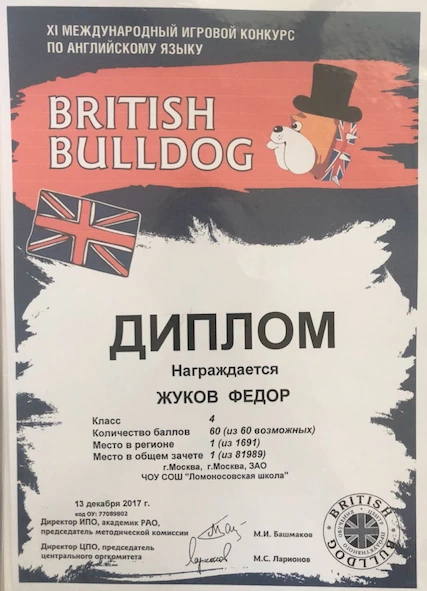Аудирование
▫ Тест 1. Аудирование. ЕГЭ по английскому языку
▫ Тест 2. Аудирование. ЕГЭ по английскому языку
▫ Тест 3. Аудирование. ЕГЭ по английскому языку
▫ Тест 4. Аудирование. ЕГЭ по английскому языку
▫ Тест 5. Аудирование. ЕГЭ по английскому языку
▫ Тест 6. Аудирование. ЕГЭ по английскому языку
▫ Тест 7. Аудирование. ЕГЭ по английскому языку
▫ Тест 8. Аудирование. ЕГЭ по английскому языку
▫ Тест 9. Аудирование. ЕГЭ по английскому языку
▫ Тест 10. Аудирование. ЕГЭ по английскому языку
▫ Тест 11. Аудирование. ЕГЭ по английскому языку
Показать все ⇓
Чтение
▫ Тест 1. Чтение. ЕГЭ по английскому языку
▫ Тест 2. Чтение. ЕГЭ по английскому языку
▫ Тест 3. Чтение. ЕГЭ по английскому языку
▫ Тест 4. Чтение. ЕГЭ по английскому языку
▫ Тест 5. Чтение. ЕГЭ по английскому языку
▫ Тест 6. Чтение. ЕГЭ по английскому языку
▫ Тест 7. Чтение. ЕГЭ по английскому языку
▫ Тест 8. Чтение. ЕГЭ по английскому языку
▫ Тест 9. Чтение. ЕГЭ по английскому языку
▫ Тест 10. Чтение. ЕГЭ по английскому языку
▫ Тест 11. Чтение. ЕГЭ по английскому языку
▫ Тест 12. Чтение. ЕГЭ по английскому языку
▫ Тест 13. Чтение. ЕГЭ по английскому языку
▫ Тест 14. Чтение. ЕГЭ по английскому языку
Показать все ⇓
Грамматика и лексика
▫ Тест 1. Грамматика и лексика. ЕГЭ по английскому языку
▫ Тест 2. Грамматика и лексика. ЕГЭ по английскому языку
▫ Тест 3. Грамматика и лексика. ЕГЭ по английскому языку
▫ Тест 4. Грамматика и лексика. ЕГЭ по английскому языку
▫ Тест 5. Грамматика и лексика. ЕГЭ по английскому языку
▫ Тест 6. Грамматика и лексика. ЕГЭ по английскому языку
▫ Тест 7. Грамматика и лексика. ЕГЭ по английскому языку
▫ Тест 8. Грамматика и лексика. ЕГЭ по английскому языку
▫ Тест 9. Грамматика и лексика. ЕГЭ по английскому языку
▫ Тест 10. Грамматика и лексика. ЕГЭ по английскому языку
▫ Тест 11. Грамматика и лексика. ЕГЭ по английскому языку
▫ Тест 12. Грамматика и лексика. ЕГЭ по английскому языку
▫ Тест 13. Грамматика и лексика. ЕГЭ по английскому языку
▫ Тест 14. Грамматика и лексика. ЕГЭ по английскому языку
▫ Тест 15. Грамматика и лексика. ЕГЭ по английскому языку
Показать все ⇓
Письмо и эссе
▫ Тест 1. Письмо и эссе. ЕГЭ по английскому языку
▫ Тест 2. Письмо и эссе. ЕГЭ по английскому языку
▫ Тест 3. Письмо и эссе. ЕГЭ по английскому языку
▫ Тест 4. Письмо и эссе. ЕГЭ по английскому языку
▫ Тест 5. Письмо и эссе. ЕГЭ по английскому языку
▫ Тест 6. Письмо и эссе. ЕГЭ по английскому языку
▫ Тест 7. Письмо и эссе. ЕГЭ по английскому языку
▫ Тест 8. Письмо и эссе. ЕГЭ по английскому языку
▫ Тест 9. Письмо и эссе. ЕГЭ по английскому языку
▫ Тест 10. Письмо и эссе. ЕГЭ по английскому языку
▫ Тест 11. Письмо и эссе. ЕГЭ по английскому языку
▫ Тест 12. Письмо и эссе. ЕГЭ по английскому языку
▫ Тест 13. Письмо и эссе. ЕГЭ по английскому языку
▫ Тест 14. Письмо и эссе. ЕГЭ по английскому языку
▫ Тест 15. Письмо и эссе. ЕГЭ по английскому языку
Показать все ⇓
Устная часть
▫ Тест 1. Устная часть. ЕГЭ по английскому языку
▫ Тест 2. Устная часть. ЕГЭ по английскому языку
▫ Тест 3. Устная часть. ЕГЭ по английскому языку
▫ Тест 4. Устная часть. ЕГЭ по английскому языку
▫ Тест 5. Устная часть. ЕГЭ по английскому языку
▫ Тест 6. Устная часть. ЕГЭ по английскому языку
▫ Тест 7. Устная часть. ЕГЭ по английскому языку
▫ Тест 8. Устная часть. ЕГЭ по английскому языку
▫ Тест 9. Устная часть. ЕГЭ по английскому языку
▫ Тест 10. Устная часть. ЕГЭ по английскому языку
▫ Тест 11. Устная часть. ЕГЭ по английскому языку
▫ Тест 12. Устная часть. ЕГЭ по английскому языку
▫ Тест 13. Устная часть. ЕГЭ по английскому языку
▫ Тест 14. Устная часть. ЕГЭ по английскому языку
▫ Тест 15. Устная часть. ЕГЭ по английскому языку
Показать все ⇓
В наушниках отвечать на вопросы компьютера в одной аудитории с несколькими выпусниками? Да, именно так проходит говорение на ЕГЭ по английскому. Шумно, страшно и очень нервно — но это решаемо. Разбираемся, как сдать устную часть на английском и не поседеть от стресса.
Говорение на ЕГЭ по английскому: к чему готовиться на устной части?
Тем, кто решил сдавать ЕГЭ по английскому языку, стоит подготовиться не только к самим заданиям, но и знать об особенностях проведения устной части экзамена. Если формальные процессы более-менее схожи с другими экзаменами, то сама сдача сильно отличается.
Во время говорения на ЕГЭ по английскому в аудитории вместе с вами будут находиться еще 3 человека, не считая организаторов. Несмотря на наушники, вы все равно будете слышать, что они говорят. Будьте готовы к этому и потренируйтесь выполнять задания в шумных местах: например, на перемене в школе или фуд-корте торгового центра.
Все задания устной части организованы в одной программе, которую организаторы настроят на компьютерах перед вашим приходом в аудиторию. В этой же программе будет таймер, чтобы вы следили за оставшимся для ответа временем.
Не бойтесь поднять руку и попросить организаторов помочь вам, если вы не уверены, как начать или продолжить выполнение заданий. Перед началом устной части и после выполнения всех заданий у вас будет возможность послушать свой ответ и убедиться, что все записалось корректно.
Помните, во время устной части нельзя делать заметки, поэтому нет смысла брать с собой ручки. Лучше возьмите воду, ведь ожидание своей очереди может быть дольше одного часа.
Обо всех этих особенностях я рассказываю своим ученикам во время подготовки к ЕГЭ по английскому. Мы также обязательно проводим пробный экзамен в формате настоящего ЕГЭ, чтобы каждому было понятно, с чем он столкнется в день сдачи. После пробного экзамена мы индивидуально разбираем ошибки и подсказываем, как их избежать на реальном ЕГЭ. Такое погружение в экзамен и помогает нашим ученикам ежегодно сдавать ЕГЭ по английскому на 80+.
Задание 1 из говорения на ЕГЭ по английскому
Задание 1 не кажется сложным: нужно прочитать небольшой текст вслух. ФИПИ также относят его к заданиям базового уровня сложности.
Однако эта простота — обманчива. В задании оценивается правильное произнесение не только отдельных звуков, но и фраз в целом, а также интонирование. Естественно, в задании могут быть ловушки с словами, которые русскоговорящие типично произносят неверно. Обычно это так называемые слова на минимальные пары. Например: bin и been, thought и though, wet и vet.
Как готовиться к заданию 1 устной части?
В первую очередь, нужно понять, нет ли у вас проблем непосредственно с произношением отдельных звуков. Если есть, нужно это исправить и только после переходить к работе с произношением слов. На этом этапе вы будете плотно работать с онлайн-словарями, в которых есть возможность послушать произношение слов.
Возьмите любой текст задания 1 из банка ФИПИ и посмотрите, как читается каждое слово в словаре. Вы удивитесь, что некоторые слова читаются совсем не так, как вы привыкли. Запишите, как вы читаете этот текст, но послушайте только на следующий день. Отметьте ошибки и запишите этот же текст слова.
Помните, чем больше слов вы встретите в текстах и отработаете их произношение, тем меньше вероятность, что на экзамене встретится слово, которое вы не знаете.
Задание 2 из устной части ЕГЭ по английскому
В задании 2 на говорение дается определенная коммуникативная ситуация. Например, вы хотите прийти на занятие танцами и вам нужно узнать дополнительную информацию. Даны 4 опорных пункта, информацию о которых нужно узнать, задав подходящий вопрос. Задание относится к базовому уровню сложности и большинство учащихся отлично с ним справляется.
Как готовиться к заданию 2?
В этом задании требуется задать прямые вопросы, поэтому для начала повторите эту тему. Для практики можно использовать любой текст — можно тот же самый, что использовали при работе с заданием 1. Придумайте минимум 10 вопросов к разной информации в тексте: людям, местам, времени. Не забудьте про вопросы к подлежащему.
На экзамене нужно уметь задавать вопросы в том числе о стоимости, наличии или отсутствии скидки и специальных предложениях — убедитесь, что вы знаете, как это сделать.
Задание 3 из говорения на ЕГЭ по английскому
С 2022 года это задание стало похоже на одно из заданий ОГЭ: нужно ответить на вопросы интервьюера. Всего будет 5 вопросов и 40 секунд для ответа на каждый из них. Вопросы могут быть абсолютно любыми, но обычно объединены одной темой.
Как готовиться к заданию 3?
Чтобы справиться с этим заданием, нужно научиться полно и точно отвечать на заданный вопрос. Для практики подойдут вопросы из раздела Speaking любого учебника по английскому. Найдите их в своем учебнике и попробуйте составить ответ. Если сразу же не получается составить хороший ответ, запишите его, затем проговорите. Закройте глаза и попробуйте еще раз дать ответ на вопрос, не подсматривая в свой ответ.
Если ваш уровень английского уже довольно хорош, попрактикуйте отвечать на вопросы вместе с известными людьми. Найдите на YouTube видео, в которых зарубежные звезды отвечают на вопросы интервью, и отвечайте вместе с ними. Например, вот как Адель отвечает на 73 вопроса журнала Vogue.
Задание 4 из устной части ЕГЭ по английскому
В этом задании вам нужно отправить своему другу голосовое сообщение, в котором вы расскажете о фотографиях для вашего совместного проекта. Всего будет 4 пункта, которые вам нужно раскрыть в своем монологе.
Как готовиться к заданию 4?
Так как задание относится к высокому уровню сложности, подготовка к нему будет серьезнее. Нужно не только научится связно говорить больше двух минут, но и использовать грамматику и лексику соответствующего уровня. И для этого потребуется время.
Придумайте любую тему проекта, какая вам нравится, и найдите к ней подходящие картинки в интернете: они должны различаться, но при этом иметь что-то общее. Посмотрите на план ответа на задание (можно найти на сайте ФИПИ) и найденные картинки, попробуйте тезисно записать свой ответ по каждому пункту плана. Когда план готов, попробуйте составить полноценный ответ, письменно или сразу устно. Запишите себя на аудио, оцените, насколько хорошо вы раскрыли каждый пункт плана, можно ли что-то добавить. Запишите улучшенную версию ответа. Не забудьте включить разнообразные грамматические структуры и интересную лексику по теме. Тренируйтесь, пока не почувствуете, что сможете легко говорить о любой теме проекта.
Несколько общих советов для сдающих устную часть ЕГЭ по английскому
Говорение на ЕГЭ по английскому очень часто пугает учеников, это факт. Но стоит только разобраться в особенностях заданий и стратегиях подготовки к ним, как страх уйдет. Постоянная практика принесет уверенность в своих силах, и тогда никакой вариант экзамена будет не страшен.
Чтобы практика действительно приносила пользу, она должна быть системной. Несколько раз в неделю вам нужно отрабатывать произношение, придумывать вопросы и отвечать на них, описывать фотографии. Важный навык для успешной сдачи устной части: уметь быстро составлять грамматически верные и лексически разнообразные предложения. Для этого пригодятся устойчивые шаблонные фразы, уверенное знание грамматики и широкий словарный запас.
Приходите на курсы подготовки к ЕГЭ по английскому в MAXIMUM Education, и за оставшееся до ЕГЭ время вы закроете все пробелы в английском. Приятный бонус: обучаясь на наших курсах, вы подготовитесь не только к устной, но и к письменной части — то есть закроете абсолютно все темы экзамена. Итог: на обе части ЕГЭ вы придете полностью подготовленными и уверенными в себе. Здорово, правда?
ЕГЭ по английскому языку
Тренажёр устной части
Варианты заданий тренажёра составлены таким образом, чтобы охватить актуальные темы возможные на реальном экзамене ЕГЭ 2020 года. Подготовка с помощью тренажёра показала свою высокую эффективность. Не упускайте время – начните заниматься сейчас!
Чтение вслух небольшого текста научно-популярного характера
Время подготовки – 1,5 минуты
Время ответа – 1,5 минуты
Максимальная оценка – 1 балл
Критерии оценки
Максимальное количество ошибок, которые Вы можете здесь допустить, это две грубые и три незначительные ошибки. Если допущено большее количество ошибок, данная часть работы будет оценена как проваленная, в 0 баллов.
Совет
Хотя задание и не подразумевает понимание текста, при подготовке, Вам лучше максимально понять его смысл. Сознательное чтение гораздо лучше воспринимается на слух и Вы будете совершать меньше ошибок.
Совет
Не спешите! Быстро – не значит хорошо, а часто и вовсе наоборот. Слушатель не должен догадываться, что Вы читаете. Читайте в комфортном для себя темпе, даже если он будет совсем медленным. Это никак не повлияет на оценку, важно лишь уложиться в 1.5 минуты.
Совет
Если Вы ошиблись в произношении слова – не беда, повторите его ещё раз правильно.
Это содержимое только для авторизованых пользователей. Пожалуйста войдите.
Необходимо ознакомиться с рекламным объявлением и задать пять вопросов на основе ключевых слов
Время подготовки – 1,5 минуты
Время ответа – 20 секунд на вопрос
Максимальная оценка – 5 баллов
Критерии оценки
Если вопрос задан правильно грамматически, фонетически, интонационно, то Вы получаете 1 балл за этот вопрос. Если Вы произнесли вопрос так, что смысл непонятен: ошиблись в интонации, неправильно задали его грамматически или произнесли слово так, что смысл его утрачен, то вопрос оценивается в 0 баллов.
Совет
Вопросы должны быть прямые! За косвенные вопросы балл не начисляется. Не описывайте картинку, не обрамляйте Ваш ответ общими фразами, просто задавайте вопросы.
Совет
Если Вы ошиблись задавая вопрос – не беда, абсолютно спокойно задать вопрос ещё раз, но уже правильно. На это задание дается по 20 секунд на вопрос, необходимо уложиться в это время.
Совет
Чтобы сдать эту часть задания на максимальный бал необходимо хорошо знать теорию прямых вопросов (построение, интонация). После 10-15 пробных заданий, покажите свои результаты специалисту, чтобы убедиться, что вы задаёте вопросы правильно.
Это содержимое только для авторизованых пользователей. Пожалуйста войдите.
Необходимо выбрать одну из трёх фотографий и описать её на основе плана
Время подготовки – 1,5 минуты
Время ответа – 2 минуты
Максимальная оценка – 7 баллов
Критерии оценки
3 балла даётся за содержание из 12-15 предложений. 2 балла за наличие вступления, заключения и логическую связь между предложениями. 2 балла за языковое оформление. Возможное кол-во ошибок: одна грубая или три негрубых.
Совет
Вы расказываете о фотографии конкретному человеку, который зашел к Вам в гости. Это не абстрактное описание неизвестно кому. Ваш ответ должен быть максимально личностным, без фантазий.
Совет
Вы описываете саму фотографию, а не события, которые происходили с людьми до или после того, как фотография была сделана.
Совет
Вас нет на фото. Вы тот, кто сделал фото. Поэтому если Вы скажете, что на фото я и моя и т.д., то получите 0 балов по причине того, что абсолютно не поняли задание.
Совет
Вы начинаете задание с предложения I’ve chosen photo number one/two/three. Это важно для проверяющего. Далее Вы можете сказать 1-2 предложения в качестве введения.
Это содержимое только для авторизованых пользователей. Пожалуйста войдите.
Необходимо сравнить две фотографии на основе предложенного плана
Время подготовки – 1,5 минуты
Время ответа – 2 минуты
Максимальная оценка – 7 баллов
Критерии оценки
Четвёртое задание оценивается по тем же критериям, что и третье. В Вашем сравнении должны присутствовать вступление, раскрытие пунктов задания, логически связанные между собой, и заключение. Количество предложений 12-15.
Совет
Записывайте себя и прослушивайте свои записи. Вы сами увидите свои основные ошибки. Когда запись покажется Вам идеальной, отправьте её на проверку специалисту.
Совет
Постоянно упражняйтесь в сравнении картинок. Это требует определённого навыка, чтобы быстро находить сходства и различия. Постарайтесь найти свои шаблоны ответов на вопросы к картинкам.
Совет
Если Вам сложно спонтанно сравнивать картинки, то запишите свой ответ на бумаге и дайте специалисту на проверку. Если Вы научитесь хорошо сравнивать картинки на бумаге, то Вам будет гораздо проще делать это устно.
Это содержимое только для авторизованых пользователей. Пожалуйста войдите.
Для корректной работы онлайн тренажёра мы рекомендуем использовать браузер Google Chrome для компьютеров Windows или Mac. Тренажёр полноценно работает на мобильных устройствах Android и iOS. Если у вас возникли технические сложности – обратитесь к странице помощи или напишите в техподдержку.
I have taught TOEFL in MOSCOW for more than 11 years. I have learned many tips and techniques about how to earn a high TOEFL score. One of the most difficult parts in every TOELF test is its speaking part. It consists of 6 questions. It is not enough just to speak English well to get the maximum points possible on the test.
Обучаю разговорному английскому. Помогу Вам подготовиться к TOEFL или ЕГЭ.
За полгода вывожу ученика начального уровня на уровень уверенного общения, свободного выражения своих мыслей. Специализируюсь на экспресс-методах обучения.
ВАРИАНТ 1
Task 1. Imagine that you are preparing a project with your friend. You have found some interesting material for the presentation and you want to read this text to your friend. You have 1.5 minutes to read the text silently, then be ready to read it out aloud. You will not have more than 1.5 minutes to read it.
The first human carrying flight technology was the hot air balloon. While unmanned balloons have been around in some form for thousands of years, the first flight with people aboard was in 1782. The large balloon on top is called an “envelope”. It holds hot air created by a heat source known a burner. The burner creates an open flame by burning a mix of propane and air. Hot air balloons are capable of floating because the hot air inside the envelope has a lower density than the colder air outside. The top of the balloon usually has a vent which allows the pilot to control the speed of ascent or descent. Passengers typically stand in a basket beneath the envelope. While most envelopes have a standard balloon shape, others are designed to look like animals, cartoon characters and other fun objects.
Task 2. Study the advertisement. You are considering celebrating your birthday at a restaurant and now you’d like to get more information. In 1.5 minutes you are to ask four direct questions to find out about the following:

- location
- music choice
- price per person
- discounts for students

Task 3. You are going to give an interview. You have to answer five questions. Give full answers to the questions (2-3 sentences). Remember that you have 40 seconds to answer each question.
Tapescript for Task 3
Interviewer: Hello everybody! It’s Future Career Channel. Our guest today is a teenager from Russia and we are going to discuss his future career. We’d like to know our guest’s point of view on this issue. Please answer five questions. So, let’s get started.
Interviewer: What two school subjects are the most important for your future job?
Student: _________________________________________
Interviewer: What job would you like to have in the future?
Student: _________________________________________
Interviewer: Do your relatives approve of your career choice?
Student: __________________________________________
Interviewer: What job did you use to like when you were younger?
Student: __________________________________________
Interviewer: Would you like to follow in your parents’ footsteps in choosing a career? Why?
Student: __________________________________________
Interviewer: Thank you very much for the interview!
Task 4. Imagine that you are doing a project “Types of Shopping” together with your friend. You have found some illustrations and want to share the news. Leave a voice message to your friend. In 2.5 minutes be ready to tell the friend about the photos:
- explain the choice of the illustrations for the project by briefly describing them and noting the differences;
- mention the advantages (1-2) of the two types of shopping;
- mention the disadvantages (1-2) of the two types of shopping;
- express your opinion on the subject of the project – which type of shopping you would prefer and why.
You will speak for not more than 3 minutes (2-3 sentences for each item of the plan, 12–15 sentences total). You have to talk continuously.
Photo 1 Photo 2
ВАРИАНТ 2
Task 1. Imagine that you are preparing a project with your friend. You have found some interesting material for the presentation and you want to read this text to your friend. You have 1.5 minutes to read the text silently, then be ready to read it out aloud. You will not have more than 1.5 minutes to read it.
Many lands that had once been swamps were drained or filled in. There are different reasons why people drained swamplands. Some were drained to fight diseases caused by insects that lived in them. Because swamps were considered unpleasant places in which to live and harmful to health, many people thought that unless they were drained the land was worthless.
Other swamps were drained to make new land. As the population grew and more land was needed, people drained swamps or filled them to make room for more farms and factories, more roads and airports.
Few people thought that it might be harmful to get rid of swamps. As swamps disappeared, other things happened. There were both more floods and more droughts than before. There were also more fires, for swamps had acted as firebreaks. Hunters noticed that there was less wild game. Wild life that once lived in the swamps was dying out, because it had no place to live.
Task 2. Study the advertisement. You are going to visit a natural history museum and now you’d like to get more information. In 1.5 minutes you are to ask four direct questions to find out about the following:

- opening hours
- special exhibitions
- transport to the museum
- ticket price
Task 3. You are going to give an interview. You have to answer five questions. Give full answers to the questions (2-3 sentences). Remember that you have 40 seconds to answer each question.
Tapescript for Task 3
Interviewer: Hello everybody! It’s Holidays and Celebrations Channel. Our guest today is a teenager from Russia and we are going to discuss holidays and celebrations in Russia. We’d like to know our guest’s point of view on this issue. Please answer five questions. So, let’s get started.
Interviewer: What public holidays are celebrated in Russia?
Student: _______________________________________
Interviewer: What is your favourite public holiday? Why?
Student: _______________________________________
Interviewer: Do you like public celebrations? Why?
Student: _______________________________________
Interviewer: How did you celebrate last Christmas?
Student: _______________________________________
Interviewer: Where would you like to spend the best New Year holidays in your life? Why?
Student: _______________________________________
Interviewer: Thank you very much for the interview!
Task 4. Imagine that you are doing a project “Best Ways of Sightseeing” together with your friend. You have found some illustrations and want to share the news. Leave a voice message to your friend. In 2.5 minutes be ready to tell the friend about the photos:
- explain the choice of the illustrations for the project by briefly describing them and noting the differences;
- mention the advantages and disadvantages (1-2) of the two ways of sightseeing;
- mention the disadvantages (1-2) of the two ways of sightseeing;
- express your opinion on the subject of the project – which way of sightseeing you prefer and why.
You will speak for not more than 3 minutes (2-3 sentences for each item of the plan, 12–15 sentences total). You have to talk continuously.
Photo 1 Photo 2
ВАРИАНТ 3
Task 1. Imagine that you are preparing a project with your friend. You have found some interesting material for the presentation and you want to read this text to your friend. You have 1.5 minutes to read the text silently, then be ready to read it out aloud. You will not have more than 1.5 minutes to read it.
People have always told stories and legends to explain natural, but mysterious, occurrences such as the Northern Lights. The Vikings believed the Northern Lights were caused by the shining weapons of warriors. The Alaskan people thought the lights were the souls of salmon, deer and other animals. The Indians told the stories of giants living in the North and thought the lights were their torches.
The Northern Lights are actually caused by electrons from solar winds. They are attracted to the poles by the magnetic fields found there. They mix with gases in the atmosphere, which causes the gases to glow. The Northern Lights are most visible in the far north. They are typically green, purple, red or blue.
Task 2. Study the advertisement. You are considering renting a bike and now you’d like to get more information. In 1.5 minutes you are to ask four direct questions to find out about the following:

- location of rentals
- documents accepted
- price per hour
- opening hours
Task 3. You are going to give an interview. You have to answer five questions. Give full answers to the questions (2-3 sentences). Remember that you have 40 seconds to answer each question.
Tapescript for Task 3
Interviewer: Hello everybody! It’s School Channel. Our guest today is a teenager from Russia and we are going to discuss school uniform. We’d like to know our guest’s point of view on this issue. Please answer five questions. So, let’s get started.
Interviewer: Do you have to wear school uniform?
Student: ___________________________________________
Interviewer: Why is it important to wear school uniform? Why?
Student: ___________________________________________
Interviewer: What clothes do you usually wear to school?
Student: ___________________________________________
Interviewer: Did your parents use to wear school uniform in the past?
Student: ___________________________________________
Interviewer: Should all school students wear uniform in the future? Why?
Student: ___________________________________________
Interviewer: Thank you very much for the interview!
Task 4. Imagine that you are doing a project “Best Places to Live for a Teenager” together with your friend. You have found some illustrations and want to share the news. Leave a voice message to your friend. In 2.5 minutes be ready to tell the friend about the photos:
- explain the choice of the illustrations for the project by briefly describing them and noting the differences;
- mention the advantages (1-2) of the two places for living;
- mention the disadvantages (1-2) of the two places for living;
- express your opinion on the subject of the project – which place for living you would prefer and why.
You will speak for not more than 3 minutes (2-3 sentences for each item of the plan, 12–15 sentences total). You have to talk continuously.
Photo 1 Photo 2
ВАРИАНТ 4
Task 1. Imagine that you are preparing a project with your friend. You have found some interesting material for the presentation and you want to read this text to your friend. You have 1.5 minutes to read the text silently, then be ready to read it out aloud. You will not have more than 1.5 minutes to read it.
Japan is an island nation in East Asia, located in the North Pacific Ocean off the coast of the Asian continent. Japan comprises the four main islands in addition to numerous smaller islands. Tokyo is the country’s capital and largest city. Mountains dominate Japan’s landscape, covering 75 to 80 per cent of the country. Historically, the mountains were barriers to transportation, limiting the economic development of isolated areas. However, with the development of tunnels, bridges, and air transportation in the modern era, the mountains are no longer an obstacle. The Japanese have long celebrated the beauty of their mountains in art and literature, and today many mountain areas are preserved in national parks. Most of Japan’s people live on plains and lowlands found mainly along the lower courses of the country’s major rivers, on the lowest slopes of mountain ranges, and along the sea coast. This concentration of people makes Japan one of the world’s most crowded countries.
Task 2. Study the advertisement. You are considering buying a new smartphone and now you’d like to get more information. In 1.5 minutes you are to ask four direct questions to find out about the following:

- price
- battery life
- image and video quality
- number of cameras
Task 3. You are going to give an interview. You have to answer five questions. Give full answers to the questions (2-3 sentences). Remember that you have 40 seconds to answer each question.
Tapescript for Task 3
Interviewer: Hello everybody! It’s Languages Channel. Our guest today is a teenager from Russia and we are going to discuss foreign languages. We’d like to know our guest’s point of view on this issue. Please answer five questions. So, let’s get started.
Interviewer: Do you like studying foreign languages? Why?
Student: _____________________________________
Interviewer: Why is it important to speak a foreign language?
Student: _____________________________________
Interviewer: How can you improve your language skills?
Student: _____________________________________
Interviewer: Could you speak English when you were five?
Student: ______________________________________
Interviewer: What foreign language would you like to learn in the future? Why?
Student: ______________________________________
Interviewer: Thank you very much for the interview!
Task 4. Imagine that you are doing a project “Zoos” together with your friend. You have found some illustrations and want to share the news. Leave a voice message to your friend. In 2.5 minutes be ready to tell the friend about the photos:
- explain the choice of the illustrations for the project by briefly describing them and noting the differences;
- mention the advantages (1-2) of zoos;
- mention the disadvantages (1-2) of zoos;
- express your opinion on the subject of the project – should zoos exist in the future and why.
You will speak for not more than 3 minutes (2-3 sentences for each item of the plan, 12–15 sentences total). You have to talk continuously.
Photo 1 Photo 2
ВАРИАНТ 5
Task 1. Imagine that you are preparing a project with your friend. You have found some interesting material for the presentation and you want to read this text to your friend. You have 1.5 minutes to read the text silently, then be ready to read it out aloud. You will not have more than 1.5 minutes to read it.
Since ancient times, humans have loved and cherished cats as their pets. Today more than 80 million cats reside in US homes, with an estimated three cats for every dog on the planet. Yet there is still a lot we don’t know about our feline friends – including what they think of their owners. After observing pet cats for several years, scientists have come to an intriguing conclusion: cats don’t really understand people the way dogs do. They tend to feel it is they who own their masters, not vice versa. On the contrary, dogs perceive people as being very different from themselves. As soon as they see a human, they change their behaviour. The way a dog plays with a human is completely different from the way it plays with a dog. Cats are independent creatures and they can easily change their owner without changing their habits.
Task 2. Study the advertisement. You are considering going on a bus tour and now you’d like to get more information. In 1.5 minutes you are to ask four direct questions to find out about the following:

- price for a person
- audio guide in English
- starting point
- duration of the tour
Task 3. You are going to give an interview. You have to answer five questions. Give full answers to the questions (2-3 sentences). Remember that you have 40 seconds to answer each question.
Tapescript for Task 3
Interviewer: Hello everybody! It’s IT Channel. Our guest today is a teenager from Russia and we are going to discuss the Internet. We’d like to know our guest’s point of view on this issue. Please answer five questions. So, let’s get started.
Interviewer: How often do you use the Internet?
Student: _______________________________________
Interviewer: What do you usually use the Internet for?
Student: _______________________________________
Interviewer: Can the Internet be dangerous? Why?
Student: _______________________________________
Interviewer: Did you use the Internet for studying last year?
Student: ________________________________________
Interviewer: Would you like to study online instead of attending classes at school?
Student: ________________________________________
Interviewer: Thank you very much for the interview!
Task 4. Imagine that you are doing a project “Ways of Spending Leisure Time” together with your friend. You have found some illustrations and want to share the news. Leave a voice message to your friend. In 2.5 minutes be ready to tell the friend about the photos:
- explain the choice of the illustrations for the project by briefly describing them and noting the differences;
- mention the advantagesc(1-2) of the two ways of spending leisure time;
- mention the disadvantages (1-2) of the two ways of spending leisure time;
- express your opinion on the subject of the project – which way of spending your leisure time you would prefer and why.
You will speak for not more than 3 minutes (2-3 sentences for each item of the plan, 12–15 sentences total). You have to talk continuously.
Photo 1 Photo 2
Нам будет приятно, если при использовании наших материалов вы будете давать ссылку на наш сайт.
Навигация по вариантам Speaking
Variant 1
3) Hobbies for teenagers
4) Weekends in the summertime
Variant 2
3) School education
4) Shopping alternatives
Variant 3
3) Friendship
4) Travel decisions
Variant 4
3) Environmental awareness
4) Modes of education
Variant 5
3) Extracurricular activities
4) Careers in demand
Variant 6
3) School life
4) Volunteer opportunities
Variant 7
3) Social media use
4) Fitness opportunities
Variant 8
3) Family relationships
4) Eco-friendly ways to travel
Variant 9
3) Household chores
4) Birthday celebration ideas
Variant 10
3) Fast food
4) Family types
Variant 11
3) Music listening habits and preferences
4) Hobby ideas
Variant 12
3) Online gaming
4) Healthy living
Variant 13
3) The Internet
4) Pastimes
Variant 14
3) School and education
4) Gift ideas
Variant 15
3) Smartphones
4) Pets in our lives
Variant 16
3) Habits
4) Winter activities
Variant 17
3) Robots
4) Life without stress
Variant 18
3) Modern technology
4) Indoor games
Variant 19
3) Public holidays
4) Adventure sports
Variant 20
3) Forms of entertainment
4) Learning environments
Variant 21
3) Seasons and seasonal activities
4) Places to celebrate Christmas or New Year
Variant 22
3) Homework
4) Summer activities
Variant 23
3) Pets
4) Accommodation choices
Variant 24
3) Jobs and careers
4) Adorable pets
Variant 25
3) Travelling
4) Museum experiences
Variant 26
3) Clothes and fashion
4) Digital pastimes
Variant 27
3) Modern conveniences
4) Team sports
Variant 28
3) Family traditions
4) Ways to get a meal on the table
Variant 29
3) Natural world
4) Friendship choices
Variant 30
3) Modern art
4) Useful languages to learn
Variant 31
3) Domestic tourism
4) English learning solutions
Variant 32
3) Higher education
4) Workplaces
Variant 33
3) Tests and exams
4) School leavers’ decisions
Variant 34
3) Values
4) Green choices
Variant 35
3) An eco-friendly lifestyle
4) Children’s summertime experiences
Variant 36
3) Daily habits
4) Technology careers
Variant 37
3) Career choices
4) Schoolwear solutions
Variant 38
3) Fashion
4) Good pets for busy families
Variant 39
3) Art
4) Keeping fit without a gym
Variant 40
3) Consumer behaviour
4) Healthy lifestyle choices
Variant 41
3) Food and eating habits
4) Teenage part-time employment
Variant 42
3) Travel experiences
4) Jobs that define the modern world
Variant 43
3) Technology and relationships
4) Family holiday ideas
Variant 44
3) Teenagers’ interests and activities
4) Popular physical activities
Variant 45
3) Teenagers and technology
4) Means of transport for urban areas
Variant 46
3) Computer hobbies
4) Nature-inspired summer activities for kids
Variant 47
3) Smart food choices
4) Ways to fight boredom
Variant 48
3) A circle of friends
4) Places to go shopping
Variant 49
3) Youth subcultures
4) Family outing ideas
Variant 50
3) Renewable sources of energy
4) Devices that enable web browsing
Variant 51
3) Space exploration
4) Extreme water adventures
Variant 52
3) Educational travel adventures
4) Summer holiday destinations
Variant 53
3) Films
4) Out-of-home leisure pursuits
Variant 54
3) Climate change and global warming
4) Family holiday ideas: transport mode preferences
Variant 55
3) Green movements
4) Career ideas for language learners
Variant 56
3) School subjects
4) Thrill-seeking adventures
Variant 57
3) Extreme activities
4) Eating places
Variant 58
3) Volunteer work
4) Traditional hobbies
Variant 59
3) Exam preparation
4) Games we play
Variant 60
3) Employment opportunities for teenagers
4) Water sports
Variant 61
3) School uniforms
4) Travel experiences
Variant 62
3) Career success
4) Hobbies for people who love tech
Variant 63
3) Peer relationships
4) Performing art forms
Variant 64
3) Health care decisions
4) Proven ways to feel happy
Variant 65
3) Dating and relationships in the digital age
4) Budget-friendly forms of physical activity
Variant 66
3) Volunteer opportunities
4) Ways to get to school
Variant 67
3) Teenagers’ interests
4) Stress busters
Variant 68
3) Ways to protect endangered animals
4) Activities children derive positive emotions from
Variant 69
3) Forms of communication
4) Summer ideas for students
Variant 70
3) Teenagers’ lifestyles
4) Types of tourism
Variant 71
3) Plastic pollution
4) Animals we keep
Variant 72
3) Foreign languages in our lives
4) Cool gadgets that make great gifts
Variant 73
3) Discoveries and inventions
4) Places to go swimming
Variant 74
3) Teens, technology and friendships
4) Types of information sources
Variant 75
3) Modern jobs
4) Ways of buying groceries
Variant 76
3) Environmental pollution
4) Summer camps
Variant 77
3) Teenage holiday preferences
4) Gaming worlds
Variant 78
3) Modern teenagers
4) Swimming experiences
Variant 79
3) Throwaway lifestyles
4) Ways to help the environment
Variant 80
3) School memories
4) Ways to support sports teams
Variant 81
3) Music and technology
4) Great family days out
Variant 82
3) Sports
4) Good places to have fun
Variant 83
3) Shopping and technology
4) Educational solutions
Variant 84
3) Ways to stay healthy
4) School events and activities
Variant 85
3) Computer technology
4) Ways of spending a summer month
Variant 86
3) Sibling relationships
4) Ways to make a classroom smarter
Variant 87
3) Ways to keep our memories timeless
4) Extreme hobbies
Variant 88
3) Learning environments
4) Music listening locations
Variant 89
3) School experiences
4) Creative outlets
Variant 90
3) Teenage environmental attitudes and behaviours
4) Places where people live
Variant 91
3) Entertainment places
4) Summer activities to strengthen family bonds
Variant 92
3) Forms of recreation
4) Summer screen time alternatives
Variant 93
3) Weather events
4) Types of sports
Variant 94
3) Important things in a teenager’s life
4) Summertime in the country
Variant 95
3) Your homeland and its people
4) Tourist attractions
Variant 96
3) Your English learning experience
4) Earth-friendly solutions
Variant 97
3) Schoolwork
4) Dining options
Variant 98
3) Online friendships
4) Outdoor recreation ideas
Variant 99
3) Summer activities
4) Outdoor fun – whatever the season!
Variant 100
3) Aspects of school life
4) After-school activities






















